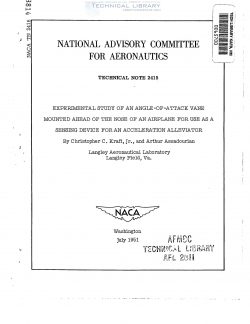naca-tn-2415
- Version
- 55 Downloads
- 389.56 KB File Size
- 1 File Count
- December 14, 2016 Create Date
- December 14, 2016 Last Updated
National Advisory Committee for Aeronautics, Technical Notes - Experimental Study of an Angle of Attack Vane Mounted Ahead of the Nose of an Airplane for Use as a Sensing Device for an Acceleration Alleviator

An investigation was made to determine the ability of a vane
mounted ahead of the nose of an airplane to give an indication of the
average angle of attack over the entire wing span during flight through
rough air. These tests were performed to determine the suitability of
such a vane as a sensing device for an acceleration alleviator. The
results show that the vane gives a sufficiently accurate measure of the
average angle of attack over the wing span to be of use for this purpose,
though rapid fluctuations in angle of attack caused by small~scale
turbulence would have to be filtered from its output.
A recent theoretical investigation of some methods for increasing
the smoothness of flight in rough air, reference 1, has considered the
use of a vane mounted at the nose of an airplane for measuring the angle—
of-attack change on the wing due to gusts. A vane mounted ahead of the
nose gives a small amount of anticipation of the action of the gusts
which would simplify the design of an acceleration alleviator by
reducing the required rate of response of the control mechanism. The
analysis of reference 1, however, assumed a constant vertical gust
velocity across the wing span. In actual flight, the gust velocity
would vary across the span, so that the question arises as to whether
vanes measuring the angle of attack at relatively few points would give
a sufficiently accurate measure of the average angle of attack caused
by gusts over the entire wing span. This question is most critical when
only a single gust detector located ahead of the nose is employed. Such
an installation would, of course, be most convenient from structural
considerations. The purpose of this investigation was to determine the
ability of such a vane to measure the average angle of attack over the
entire wing. A special vane capable of measuring high~frequency
disturbances was,used for these tests to obtain as accurately as possible
the actual local angle-of-attack variations in the region of the vanes.
Standard NASA photographically recording instruments were used to
obtain the data presented in this paper with the exception of the angle-
of-attack recorder. Measurements were made of the normal acceleration,
indicated airspeed, inclination of the airplane thrust axis, and the
angle of attack. A timer was also used to synchronize all of the records.
The natural frequency of the normal accelerOmeter was 8.75 cycles per
second and the damping of the accelerometer element was 0.7 of critical.
| File | Action |
|---|---|
| naca-tn-2415 Experimental Study of an Angle of Attack Vane Mounted Ahead of the Nose of an Airplane for Use as a.pdf | Download |
Comment On This Post